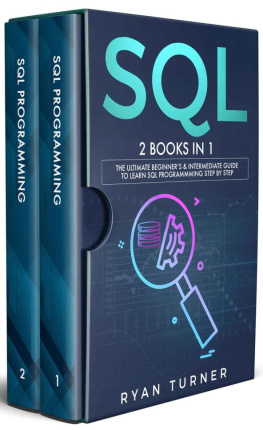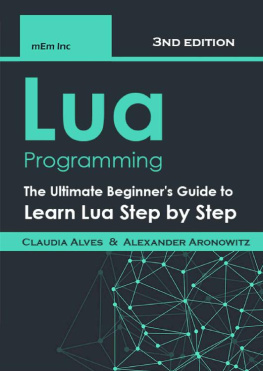Ryan Turner - SQL: 2 books in 1 - The Ultimate Beginners & Intermediate Guide to Learn SQL Programming step by step
Here you can read online Ryan Turner - SQL: 2 books in 1 - The Ultimate Beginners & Intermediate Guide to Learn SQL Programming step by step full text of the book (entire story) in english for free. Download pdf and epub, get meaning, cover and reviews about this ebook. year: 2019, genre: Computer. Description of the work, (preface) as well as reviews are available. Best literature library LitArk.com created for fans of good reading and offers a wide selection of genres:
Romance novel
Science fiction
Adventure
Detective
Science
History
Home and family
Prose
Art
Politics
Computer
Non-fiction
Religion
Business
Children
Humor
Choose a favorite category and find really read worthwhile books. Enjoy immersion in the world of imagination, feel the emotions of the characters or learn something new for yourself, make an fascinating discovery.
- Book:SQL: 2 books in 1 - The Ultimate Beginners & Intermediate Guide to Learn SQL Programming step by step
- Author:
- Genre:
- Year:2019
- Rating:5 / 5
- Favourites:Add to favourites
- Your mark:
- 100
- 1
- 2
- 3
- 4
- 5
SQL: 2 books in 1 - The Ultimate Beginners & Intermediate Guide to Learn SQL Programming step by step: summary, description and annotation
We offer to read an annotation, description, summary or preface (depends on what the author of the book "SQL: 2 books in 1 - The Ultimate Beginners & Intermediate Guide to Learn SQL Programming step by step" wrote himself). If you haven't found the necessary information about the book — write in the comments, we will try to find it.
Ryan Turner: author's other books
Who wrote SQL: 2 books in 1 - The Ultimate Beginners & Intermediate Guide to Learn SQL Programming step by step? Find out the surname, the name of the author of the book and a list of all author's works by series.
SQL: 2 books in 1 - The Ultimate Beginners & Intermediate Guide to Learn SQL Programming step by step — read online for free the complete book (whole text) full work
Below is the text of the book, divided by pages. System saving the place of the last page read, allows you to conveniently read the book "SQL: 2 books in 1 - The Ultimate Beginners & Intermediate Guide to Learn SQL Programming step by step" online for free, without having to search again every time where you left off. Put a bookmark, and you can go to the page where you finished reading at any time.
Font size:
Interval:
Bookmark:
SQL: 2 BOOKS IN 1
The Ultimate Beginner's & Intermediate Guide to Learn Python Machine Learning Step by Step using Scikit-Learn and Tensorflow
Copyright 2018 - All rights reserved.
The content contained within this book may not be reproduced, duplicated or transmitted without direct written permission from the author or the publisher.
Under no circumstances will any blame or legal responsibility be held against the publisher, or author, for any damages, reparation, or monetary loss due to the information contained within this book. Either directly or indirectly.
Legal Notice:
This book is copyright protected. This book is only for personal use. You cannot amend, distribute, sell, use, quote or paraphrase any part, or the content within this book, without the consent of the author or publisher.
Disclaimer Notice:
Please note the information contained within this document is for educational and entertainment purposes only. All effort has been executed to present accurate, up to date, and reliable, complete information. No warranties of any kind are declared or implied. Readers acknowledge that the author is not engaging in the rendering of legal, financial, medical or professional advice. The content within this book has been derived from various sources. Please consult a licensed professional before attempting any techniques outlined in this book.
By reading this document, the reader agrees that under no circumstances is the author responsible for any losses, direct or indirect, which are incurred as a result of the use of information contained within this document, including, but not limited to, errors, omissions, or inaccuracies.
TABLE OF CONTENTS
SQL
THE ULTIMATE BEGINNER'S GUIDE TO LEARN SQL PROGRAMMING STEP BY STEP
Never write when you can talk. Never talk when you can nod. And never put anything in an e-mail. Eliot Spitzer
On a hard disk, data can be stored in different file formats. It can be stored in the form of text files, word files, mp4 files, etc. However, a uniform interface that can provide access to different types of data under one umbrella in a robust and efficient manner is required. Here, the role of databases emerges.
The definition of a database is a collection of information stored in computer in a way that it can easily be accessed, managed and manipulated.
Databases store data in the form of a collection of tables where each table stores data about a particular entity. The information that we want to store about students will be represented in the columns of the table. Each row of the table will contain the record of a particular student. Each record will be distinguished by a particular column, which will contain a unique value for each row.
Suppose you want to store the ID, name, age, gender, and department of a student. The table in the database that will contain data for this student will look like this:
SID | SName | SAge | SGender | SDepartment |
Tom | Male | Computer | ||
Mike | Male | Electrical | ||
Sandy | Female | Electrical | ||
Jack | Male | Computer | ||
Sara | Female | Computer |
Student Table
Here, the letter S has been prefixed with the name of each column. This is just one of the conventions used to denote column names. You can give any name to the columns. (We will look at how to create tables and columns within it in the coming chapters.) It is much easier to access, manipulate, and manage data stored in this form. SQL queries can be executed on the data stored in the form of tables that have relationships with other tables.
A database doesnt contain a single table. Rather, it contains multiple related tables. Relationships maintain database integrity and prevent data redundancy. For instance, if the school decides to rename the Computer department from Computer to Comp & Soft, you will have to update the records of all students in the Computer department. You will have to update the 1st, 4th, and 5th records of the student table.
It is easy to update three records; however, in real life scenarios, there are thousands of students and it is an uphill task to update the records of all of them. In such scenarios, relationships between data tables become important. For instance, to solve the aforementioned redundancy problem, we can create another table named Department and store the records of all the departments in that table. The table will look like this:
DID | DName | DCapacity |
Electrical | ||
Computer | ||
Mechanical |
Department Table
Now, in the student table, instead of storing the department name, the department ID will be stored. The student table will be updated like this:
SID | SName | SAge | SGender | DID |
Tom | Male | |||
Mike | Male | |||
Sandy | Female | |||
Jack | Male | |||
Sara | Female |
Table Student
You can see that the department name column has been replaced by the department id column, represented by DID. The 1st, 4th, and 5th rows that were previously assigned the Computer department now contain the id of the department, which is 102. Now, if the name of the department is changed from Computer to Comp & Soft, this change has to be made only in one record of the department table and all the associated students will be automatically referred to the updated department name.
- Advantages of Databases
The following are some of the major advantages of databases:
- Databases maintain data integrity. This means that data changes are carried out at a single place and all the entities accessing the data get the latest version of the data.
- Through complex queries, databases can be efficiently accessed, modified, and manipulated. SQL is designed for this purpose.
- Databases avoid data redundancy. Through tables and relationships, databases avoid data redundancy and data belonging to particular entities resides in a single place in a database.
- Databases offer better and more controlled security. For example, usernames and passwords can be stored in tables with excessive security levels.
- Types of SQL Queries
On the basis of functionality, SQL queries can be broadly classified into a couple of major categories as follows:
- Data Definition Language (DDL)
Data Definition Language (DDL) queries are used to create and define schemas of databases. The following are some of the queries that fall in this category:
- CREATE to create tables and other objects in a database
- ALTER to alter database structures, mainly tables.
- DROP - delete objects, mainly tables from the database
- Data Manipulation Language
Data Manipulation Language (DML) queries are used to manipulate data within databases. The following are some examples of DML queries.
Font size:
Interval:
Bookmark:
Similar books «SQL: 2 books in 1 - The Ultimate Beginners & Intermediate Guide to Learn SQL Programming step by step»
Look at similar books to SQL: 2 books in 1 - The Ultimate Beginners & Intermediate Guide to Learn SQL Programming step by step. We have selected literature similar in name and meaning in the hope of providing readers with more options to find new, interesting, not yet read works.
Discussion, reviews of the book SQL: 2 books in 1 - The Ultimate Beginners & Intermediate Guide to Learn SQL Programming step by step and just readers' own opinions. Leave your comments, write what you think about the work, its meaning or the main characters. Specify what exactly you liked and what you didn't like, and why you think so.



